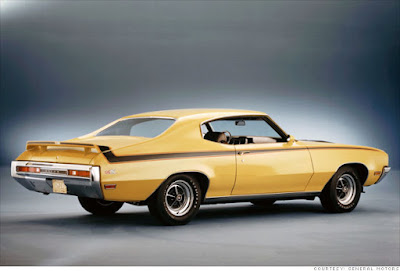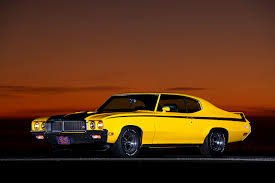From 1970 to 1072, Buick sold their rare GSX muscle car to the public, finally getting an edge over their other A-Body competitors. The Chevelle SS, GTO Judge, and Olds 4-2-2 weren’t quite their enemies, but Buick needed to bring something to the table to compete with them. The GSX and the GSX Stage 1 did that and more for Buick. Hosting more power and torque, better times at the race track, a sportier suspension, and a more comfortable interior with better materials, these classic cars put Buick at the top of the muscle car list.
With eye-catching stripes, a front and rear spoiler, a hood tach, and the GS ram air hood, the GSX was definitely a car that would get you noticed when driving down the road. And if you felt like you weren’t getting noticed enough, a pedal-to-the-metal action to activate Buick's massive torque offering would burn the tires off with ease—letting everyone around you know that your Buick GSX meant business. Tough to drive when you lack traction, but fun to drive if you knew what you were doing.
All the muscle cars from this era were fun, but they were being produced on borrowed time. When the full weight of stricter emissions standards was implicated, the muscle car industry and its success in pleasing gearheads were over.
10. The GS455 Stage 1 Didn't Draw Enough Attention
Although the Buick GS Stage 1 shared the same A-body structure as the GTO Judge, Chevelle SS, and the Oldsmobile 422, Buick just couldn't get their sales up because they couldn't shake the stigma of being a car that your grandmother would drive. So mid-way through the production year of 1970, Buick came out with the stout, sporty-looking Buick GSX.
9. The Buick GSXs Are Limited Edition
It may not seem like it because there is an abundance of GSXs out there, but many of them are clones. If you go to the GS Nationals in Kentucky, it’ll seem like there are way more than just the numbers that are shown to be produced. But thanks to companies like T/A Performance from Arizona—people have the opportunity to own an almost identical GSX without paying the price of a low-mileage real GSX.
Nowadays, with the way technology is, it is very hard to tell the difference between a real GSX and a clone without an official build sheet. But to put the numbers in perspective, there were 678 Buick GSXs built in 1970, 124 built in 1971, and only 44 built in 1972. Sure, building a clone for a good price as an average car guy is a good thing, but for the serious car collector, it makes it seem their super rare numbers matching GSX is a little less important or rare when you can’t tell the difference between a real one and an imposter.
8. Autmoblies to "To Light Your Fire" Buick's Slogan
Depending on who you ask, either the Buick slogan campaign helped both Buick and the Doors or it helped Buick and hurt the Doors. The Slogan comes from a famous Doors song, “Come on, Baby, Light My Fire.” GM paid the touring band $75,000 for the use of the words in print, radio, and TV ads.
The new GSX sport appearance package and the 1966 song lyrics were a campaign to bring the fire that the GSX needed to help Buick shake the grandma’s church-going grocery-getting reputation it acquired in the past.
On tour at the time, minus Jim Morrison, the Doors had no problem with the idea, but Morrison was furious. Apparently, Morrison was so enraged that he threatened to set a Buick on fire on stage during their next concert. He wanted his bandmates and the band’s label (Elektra) to cancel the contract, but the damage had already been done.
7. Underrated Horsepower And Torque Rating
Most people, including NHRA, claimed that the engine probably put out 400+ horsepower. Using the GSX's time in the quarter-mile and the weight of the car, experts who tested the Buick knew that there was more horsepower than what was being advertised.
6. Motor Trend Names the 1970 Buick GSX “The Quickest American Production Car”
Although the 1970 Buick GSX was named the quickest, the 1971 and ‘72 GSXs fell victim to the emission laws and received lower compression V8 engines. In fact, you were even able to order up your GSX with a 350, 400, or a 430 cu.-in motor, unlike in 1970 when a 455 cu.-in. engine was your only option. You still got the sporty look, but the power the Buick had was starting to take a huge hit. The only good thing for Buick was that everyone else in the industry had to follow the same emission rules and regulations, making your typical car guy very sad.
5. The Ram Air Hodd and Housing Never Really Functioned
In theory, the ram air hood on the Buick GSXs should have helped whatever powerplant you had under the hood gain about 8% horsepower, at least that’s what Buick was claiming. Unfortunately, it didn’t. In fact, most experts who tested the ram air system claim to have noticed no difference. Even worse, in race testing, experts noticed that the housing and the scoops themselves were too oddly shaped and even restricted flow.
Taking the whole ram air system off and letting the carburetor breathe without the ram air housing actually promoted a little better performance. These air cleaner housings do look cool, but they don’t serve up any extra horsepower gains.
4. There was an Internal Band on Large Buick cu.-in. Engines
Lifting the large engine band was a no-brainer for Buick because they weren’t just competing against their A-body siblings, but they also had to throw down with Fords and Hemis. Buick knew if they were going to keep up with all the other muscle cars, a 400 cu.-in. engine just wasn’t going to cut it. They also knew they were going to have to make more changes than just engine displacement upgrades.
3. Heavy Duty Suspension, Disc Brakes, Wheels, and Tires
To add to the performance of the GSX, Buick made sure that the suspension could handle the power. A front anti-roll bar was included, along with stronger shocks and rear lower control arms. All the suspension bushings were upgraded to stiffer high-performing bushing. Also included was a quick-ratio steering gearbox to give the driver a better road feel.
For the brake system, there were a few different options. There were 11-inch ventilated rotors in the front with signal-piston calipers as long as you order the Stage 1 455 GSX. In the rear, there were upgraded drum brakes and power assist was optional. On different orders, you might have received drum brakes all the way around.
2. Find That GSX Build Sheet
Finding the build sheet for a GSX is a big deal. What the build sheet says will give you an idea of how much you should be paying for a particular vehicle. Even if a true GSX is a little beat up, paying big bucks for one isn't uncommon and could still be very well worth the money. But if you pay big bucks for a GSX, and it’s really just a Skylark in disguise, you can lose big money.
1. The Little Extras That Make The GSX Different From GS
There were some other features that you would get with the GSX that you wouldn’t get with lower-trim level Buicks. Color-matching mirrors and headlight bezels added to the colorful look of the GSX. The rear spoiler was an option on some GS Buick 455s but with the GSX package, it was standard.
Other features were a standard heavy-duty cooling system, the option of a close-ratio four-speed or three-speed manual, or a TH400 automatic transmission. For the rear gear ratio, if you order a Stage 1 package, you would get bumped up to a positraction 3.64:1 axle that would help you burn the tires and create smoky hole shots whenever you wanted to.


















